TECHNICAL REFERENCE
Resident mx-5 guru and Life Member Ian Lewis regularly writes technical articles for our club magazine "MX-Press".
Below are a selection of these. If you would like to know more, become a member and receive the club magazine.
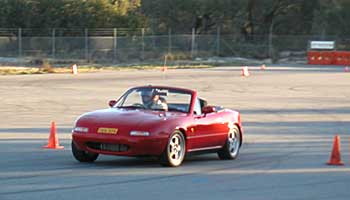
Cooling
There’s nothing like learning from your own mistakes! I recently replaced my radiator coolant as you should every year or so. Having a container full of BP Ethylene Glycol, anti-boil/anti-freeze in the garage, I carefully mixed it with the recommended amount of distilled water and filled the cooling system. On a warm morning I drove 45kms to the Autokhana venue, the final few straights at full throttle. I pulled into the car park and heard a hissing noise - the cooling system was boiling and overflowing! After it cooled down I topped up the header tank and began the morning’s competition. Following the last 40 second run the hissing reappeared! I’d never experienced overheating in these environments before. This morning I pulled out the technical blurb from Redline and was reminded of why I didn’t use EG previously. Ethylene Glycol is very good at stopping your coolant from freezing (not a high priority in WA), but not very good at carrying heat out of the engine. In fact water is the best carrier of heat and all you need to add is a corrosion inhibitor.
Water Wetter ™ stopped my overheating problem on the road and in Autokhana competitions.
Some members with turbo cars have fitted larger capacity radiators, but it appears that no-one’s found one that can handle more than half a dozen laps of a race track. The problem seems to be lack of air rather than water. Some Victorian MX-5 Turbos have air escape vents cut into their bonnets, stay tuned for the results.
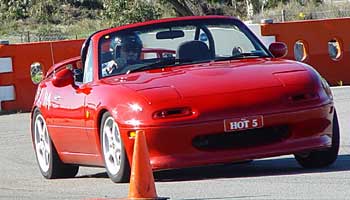
An extra, ducted air vent above the bumper line allowed more air to ‘see’ the top third of the radiator, but I’m not convinced it increased the airflow through it.
A 50mm aluminium radiator from PWR made the most difference. It kept the temperature below 100şC at a Barbagallo short track sprint evening even with two on-board.
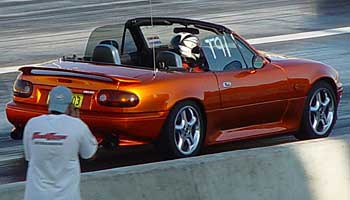
Diffs
Inside wheel spin exiting slow corners maintains stability, but limits acceleration for competing MX-5s.
Mazda viscous or TorSen LSDs limit this wheelspin and pretty soon the loaded wheel catches the speed of the spinning wheel, but increasing my engine's peak torque by 250% has caused the driven wheel to sometimes take the whole straight to catch up, wasting a lot of power and time, so I've 'hit the books' to find out what the various types of competition diffs have to offer. As usual there are pros and cons to each. I've imported a KAAZ 1.5-way LSD and had it fitted by Racetorque. ($1,960 including replacement bearings and oil).
| TYPE | PROS | CONS |
|---|---|---|
| Open | Reliable Lightweight Low moment of rotational inertia Easy on the drive train & tyres Does not affect handling |
Inside wheel spin wastes power, acceleration & time, especially on bumpy tracks & out of slow corners High power-to-weight cars will spin a wheel on the straight! |
| Viscous | Reliable Lightweight Low moment of rotational inertia 40% Lock-up Tuneable (not in the field) Standard in Clubman model |
Continuous high power causes high fluid temperature and reduction of lock-up Requires re-build to modify |
| TorSen | Ideal for high performance road cars & AWDs Senses the traction available at each wheel and splits the torque proportionally Standard (60% Bias) in some models from 1994 New lightweight ZG TorSen II (80% Bias) from 1997 |
Heavy weight Does not fully lock High dynamic friction (loss of corner exit power) High moment of rotational inertia (flywheel effect adds to braking load) Iron diff cases (RX7) prone to fracture in high powered cars |
| Clutch | Moderate weight Low moment of rotational inertia Adjustable bias via changing accel/decel ramp angles (30°-85°), number of clutch plates & pre-load Progressive, smooth lock-up | Increased tyre wear Requires periodic maintenance to counteract component wear |
| 2-Way Clutch | Suits high speed race circuits Reduces rear brake lock-up |
Slow-corner entry & mid-point understeer |
| 1-Way Clutch | Suits motorkhanas (low speed corners) No corner entry understeer |
Increased ramp & pinion shaft wear |
| 1.5-Way Clutch | Suits autokhanas (medium speed tracks) | Slow-corner entry understeer |
The KAAZ diff didn’t last very long. 300Nm was too much torque for it. The hardened plates bit into the softer material of the housing, causing them to stick. The replacement Cusco diff is of the same design, but stronger materials and is OK so far.
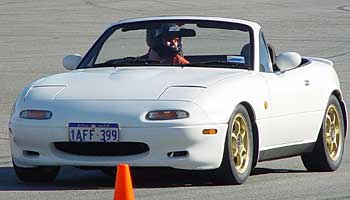
Fuel
This may sound like an advert for BP Ultimate, but why wouldn't you want more economy, more power, less pollution and a cleaner engine? When compared to other unleaded petrol, Ultimate has 80% less benzine, and 90% less sulphur (the stuff that clogs your fuel injectors and smells like eggs). BMW tests showed significantly less inlet valve deposits when running on Ultimate. And it's only $2 a tankful dearer.
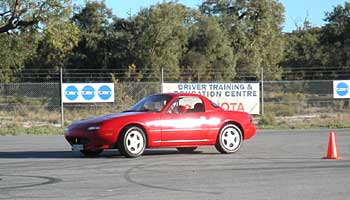
Harnesses
Most FIA homologated equipment has a five-year life. If your seat and/or harness are made to FIA spec and you compete in a form of motorsport where FIA compliance is mandatory, it must be replaced by its use-by date. The latest CAMS mag says that if your harness is FIA and it's past its expiry date it has to be replaced no matter what form of motorsport you're involved in. I haven't been able to find this in the CAMS manual, so if you're thinking of buying a new harness I suggest you speak to CAMS first and if you're not intending competing in FIA events, buy a harness that doesn't have a use-by date on its tag.
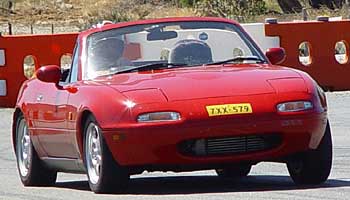
MazdaSpeed Competition Parts
Bill Wilner [sales@mazdaspeed.net] has agreed to supply MX-5 Club of WA members with MazdaSpeed parts (previously unavailable unless you were a registered Miata racer with an SCCA licence).
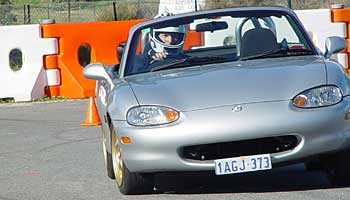
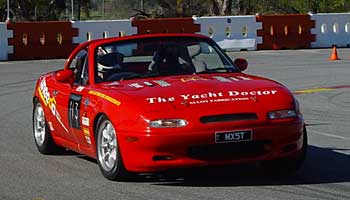
Suspension - Camber
If you've been reading articles in other mags or web sites, you may be more than a bit confused about suspension settings. I could say its basic physics, but it ain't that simple! Some "experts" will tell you you need lots of negative camber, the theory being if a bit's good, then more's gotta be better! If your car has standard suspension components, body roll when cornering fast will increase the wear on the tyre’s outside shoulders. One fix is to increase the negative camber: not too much though, coz when the suspension is loaded it goes negative anyway. For motorkhanas -1° should be enough. Autokhanas (medium speed corners) may need -1° at the rear and as much as -2.5° at the front. For track work (high speed corners) more negative camber may be required, but be aware that this will cause your tyres to wear their inside edges prematurely when commuting.
You need less camber if you reduce body roll by lowering, stiffening and lightening your car. As the ride height is decreased the camber goes more negative. At 90mm my rears had a minimum of -2.5°. This was undesirable for two reasons. The inside edge of my tyres wore much faster than the outer and I lost straight-line grip. The Yacht Doctor recently lengthened my upper wishbones by 10mm to correct this. I'm now running just -0.5° rear and 1.5° front. The only way to tell if you've got the camber settings right is to measure your tyre tread depth regularly. The depth should be even across the tread. Also, if the centre of the tyre has less depth than the shoulders, lower the pressure. With Bridgestone 540S 215/50-15s I run 25psi cold.
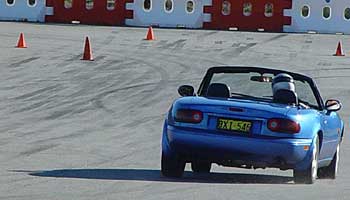
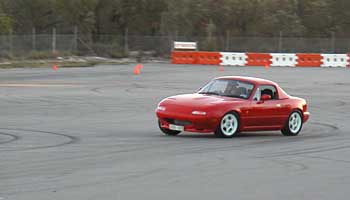
Suspension - Ride Height
MX-5s ride quite high, especially at the rear. Lowering your ride height by replacing springs &/or fitting adjustable height shocks (20mm front, 30mm rear) will reduce weight transfer when cornering and destabilising tail lift during braking. Lowering your ride height reduces your need for negative camber slightly, but go too low and your car may be illegal and have too much negative camber. You can regain adjustment by lengthening your upper rear wishbones.
Suspension - Shock Absorbers
Dampers wear out. You may not notice, because it happens very gradually, but they should be tested and probably replaced after 100,000 kms. There are many brands and models available. Koni offer matched shock & spring kits with threaded ride height adjustment and external rebound damping adjustment for MX-5 NAs and Sports shocks with circlip adjustment of ride height and rebound damping for all models. German brand H&R have lowering springs for all years and spring/shock kits for MX-5 NBs.
Suspension - Springs
Mazda’s springs are pretty good, unless you want a lower &/or firmer ride. Just make sure they are matched to the shocks otherwise things will get nasty!
Suspension - Toe-In
These settings are best left to the experts as they can easily destabilise the car if changed too far from the factory settings. John Fowler Autosport is an expert in the black art of suspension settings and has performed wonders on the Autokhana Team’s cars.


Full Throttle?
Throttle cables stretch over time, reducing your throttle opening and maximum power. To adjust it, place a broom stick between your seat and the fully depressed pedal, then check your throttle butterfly is fully open. If not, loosen the lock nut and take up the slack, then retighten the lock nut.
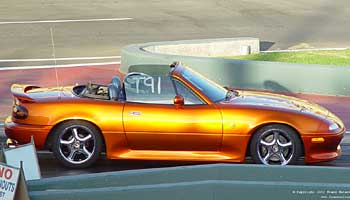
Traction Control
Some after-market engine control computers have traction control. You simply program the minimum revs & road speed and the percentage of slip & rate of power reduction you want in each gear and the computer does the rest. Just aim and shoot. Shouldn't take me more than a year or two to fine tune it!
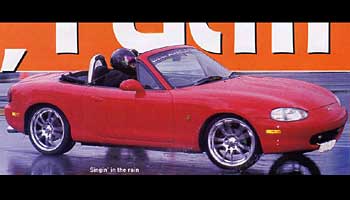
Tyres
If you’re serious about driving fast, you should consider getting sticky rubber. Our autokhana team have reduced their times by 2 or 3 seconds just by changing to R compound tyres. And if you drive less than 5,000kms a year you may as well leave them on all the time, because R compounds will be too hard for competition after two years, driven or not. John Fowler Autosport will recommend the best available at special club member rates but please check with our Motorsport officials because some tyres are banned within our club motorsport to help keep club motorsport affordable.
LATEST NEWS
- 27/06EOI Timed Motorsport at Jack's Hill
- 18/02New Life Member - Don Messenger
- 05/04CANCELLED S12R2 this Sunday 10/04/22 CANCELLED
- 05/032022 Motorsport ENTRIES NOW OPEN
PAST EVENTS
- 15/10After Work Get Together - Barefoot Bowls
- 12/10Erskine To The Sandy Cove Taven
- 05/10Monthly Cruise – Observation Rally
- 28/09Dawn BreakFast Raid - York Medival Fayre
COMING EVENTS
- 22/10Monthly Committee Meeting
- 25/10Saturday Lunchtime Cruise - Brookton Burger Co.
- 02/11Club 35th Anniversary Cruise to the Yanchep Inn
- 09/11Southern MX-5
Lakelands to the Whistling Kite Tavern - 11/11Afterwork Get Together - Cruise & Cheap Eats
- 22/11Saturday Lunchtime Cruise - BMT Garden & Cafe
- 26/11Monthly Committee Meeting
- 30/11Dawn BreakFast Raid - Masonmill Garden
- 07/12Sunday Cruise Santa’s Sleigh Ride to Summer Creek
- 04/01Sunday Cruise - Bob's Collectors Cruise
- 01/02Monthly Cruise - The Rec Waroona
- 01/02Southern MX-5
Combined Run to the Rec Hotel in Waroona - 07/02Annual Dinner @ Stirling Arms Hotel, Guildford
- 15/02Dawn BreakFast Raid - Jarrahdale Local PO Kitchen